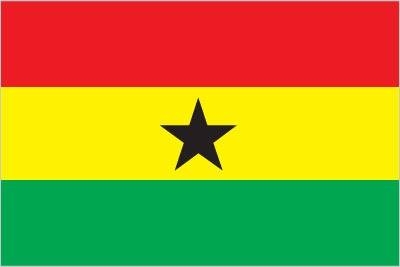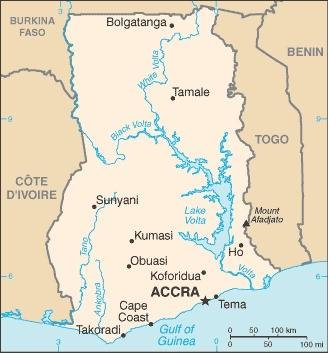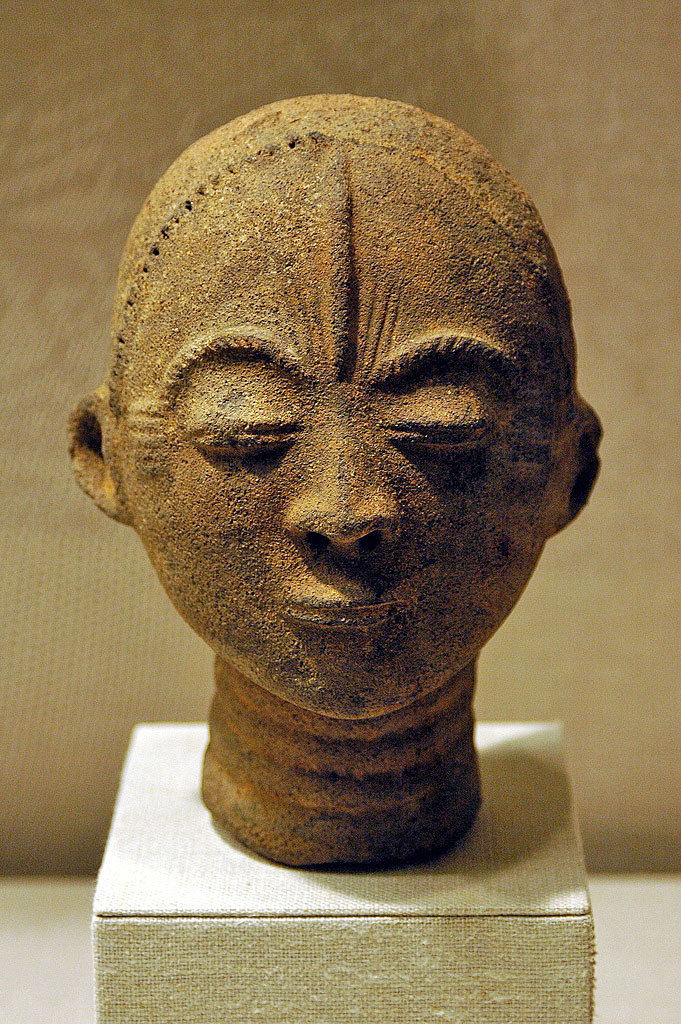199 Ghana

Three equal horizontal bands of red (top), yellow, and green, with a large black 5-pointed star centered in the yellow band. Red symbolizes the blood shed for independence, yellow represents the country’s mineral wealth, while green stands for its forests and natural wealth. The black star is said to be the lodestar of African freedom.
Flag courtesy of the CIA World Factbook

Map courtesy of the CIA World Factbook

16th-century Akan Terracotta, Metropolitan Museum of Art
Government
According to Britannica, the 1992 constitution provides for a multiparty republic with a president as head of state and a vice president. The president is elected for a term of four years (with the possibility of reelection for one further term) by universal adult suffrage. There is a broadly based Council of State with deliberative and advisory functions as well as a unicameral Parliament, whose members are directly elected to four-year terms. The president appoints the cabinet, which averages between 20 and 25 members.
Dating to the period of British colonial rule, chieftaincy and the traditional political authorities have tended to run along parallel lines with the central government. Since independence, this tendency has persisted or even expanded, and the institution of chieftaincy has become increasingly divorced from the exercise of real political power at almost all levels of government; its role now is largely ceremonial.
Ghana is divided into 16 regions, Ahafo, Ashanti, Bono, Bono East, Central, Eastern, Greater Accra, North East, Northern, Oti, Savannah, Upper East, Upper West, Volta, Western, and Western North, which are further subdivided into districts. The 1992 constitution provided for elected District Assemblies, to which government-appointed members and an appointed District Chief Executive are added. However, district and local government members are not to have political party affiliation.
The judicial system is based chiefly on the English model, but Ghanaian customary law is recognized as well as English common law. The administration of justice is handled by various courts divided into two groups: the superior courts, consisting of the Supreme Court, the Court of Appeal, and the High Court; and inferior courts, consisting of the circuit courts, the district courts, and other courts provided by law, such as the juvenile courts. The adjudicating authorities in chieftaincy and purely traditional matters are the regional and National House of Chiefs. Appeals from decisions of the National House of Chiefs are made directly to the Supreme Court.
Ghana Civil Aviation Authority (GCAA)
The Ghana Civil Aviation Authority (GCAA) is the regulatory agency of the Republic of Ghana for air transportation in the country. It also provides air navigation services within the Accra Flight Information Region (FIR), which comprises the airspace over the Republic of Ghana and a large area over the Atlantic Ocean in the Gulf of Guinea. The GCAA was established in 1930 as a unit with Public Works Department (PWD); in 1953 GCAA was granted Departmental Status. It became an Authority under PNDC Law 151 from 16th May, 1986. In the year 2004 the GCAA Act was enacted to replace PNDC Law 151. The Civil Aviation Act, Act 678 of November 2004 provides for the establishment of a Civil Aviation Authority, which will focus on the core functions of Airspace management and Safety Regulations whilst allowing for a different organization to handle Airport development and operations. Pursuant to the above, the GCAA was restructured into two bodies, that is, the new GHANA Civil Aviation Authority (GCAA) and the Ghana Airports Company Limited (GACL) on 1st January, 2007.
Airspace
SkyVector – Google Maps – ADS-B Exchange
ICAO countries publish an Aeronautical Information Publication (AIP). This document is divided into three parts: General (GEN), En Route (ENR) and Aerodromes (AD). ENR 1.4 details the types of airspace classes they chose to adopt from classes A through G.
Drone Regulations
Customs Clearance/Importation Application Form.
Recreational and Private Operations Application Form
Recreational and Private Operations Checklist
Commercial Operations Checklist
Commercial Operations RPAS Guidance Material
Commercial Operations Certification Process
Commercial Operations Advisory Pamphlet
Commercial Operations Prospective Operator Per-Assessment Statement
Commercial Operations Oversight Responsibility
Approval Process for Special Authorization Application Form
Approval Process for Special Authorization Checklist
Procedure for Pilot and Pilot Instructor Licensing Application Form
Procedure for Pilot and Pilot Instructor Licensing Checklist
Procedure for Approval for Sale of RPAS Application Form
Procedure for Change of Ownership of an RPAS Application Form
RPAS Associations/Clubs Response Sample Letter
Remotely Piloted Aircraft Systems Directives
Guidelines for RPAS Category of Operations (CONOPS)
Assessment of Risk for RPAS Operators (ARRO) Methodology
Advanced Air Mobility (AAM) Regulations & Policies
None found by the author.
However, should you, the reader, happen to stumble across something to the contrary, please email the author at FISHE5CA@erau.edu and you may be mentioned in the ACKNOWLEDGEMENTS section of this book by way of thanks for contributing to this free eBook!
Advanced Air Mobility (AAM) News
None found by the author.
However, should you, the reader, happen to stumble across something to the contrary, please email the author at FISHE5CA@erau.edu and you may be mentioned in the ACKNOWLEDGEMENTS section of this book by way of thanks for contributing to this free eBook!
Short Essay Questions
Scenario-Based Question
You have been hired by a Drone Startup Company. Your boss has immediately assigned this job to you.
They need you to prepare a one-page memo detailing the legalities of using a drone to film Elmina Castle in Ghana.
They need you to mention any national laws and local ordinances.
They specifically want to know what airspace (insert pictures) you will be operating in and whether or not you need an airspace authorization.
Does it matter whether or not you are a citizen of the country?
Lastly, there is a bonus for you if, as you scroll through this chapter, you find any typos or broken links!
Short Essay Questions
- What are the drone categories?
- How is registration addressed?
- How is remote ID addressed?
- What are the model aircraft rules?
- What are the commercial drone rules?
- Are there waivers or exemptions to the rules? If so, for what?
- Would you share a link to an interactive airspace map?
- How is BVLOS addressed?
- How can you fly drones at night?
- How can you fly drones over people?
- Where do you find drone NOTAMs?
- What are the rules for drone maintenance?
- What are the rules for an SMS program?
- What are some unique rules not mentioned above?
- What are the C-UAS rules?
- What are the AAM rules?

